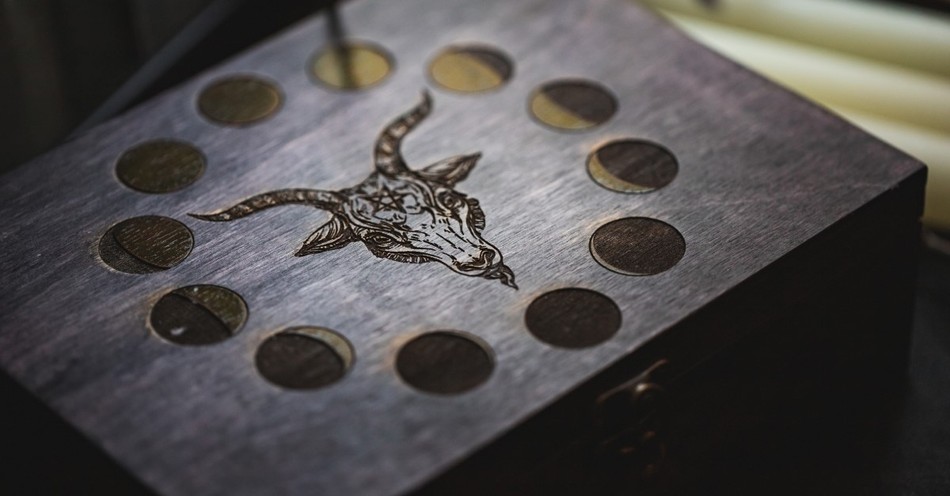Most of us spend little time thinking about false gods and created idols. Recently, however, a controversial billionaire wore a Halloween costume featuring symbolism that resembled a false god and deity known as Baphomet. The costume caused some people great concern and stirred others to ask, “Who is Baphomet, and why would I be worried about someone idolizing him?”
What is Baphomet?
Baphomet is an invention, a false god whose appearance isn’t even documented until fairly recent times. Contemporary depictions of Baphomet include a goat’s head on a human body with male and female traits, often sitting cross-legged. It features a symbol on its torso of two snakes intertwined around a sword, a pentagram on its forehead, and often a larger pentagram behind its head. In fact, the goat face that distinguishes Baphomet from other idols is shaped like a pentagram with two upright horns, two outward stretching ears, and a goatee. According to some reports, this representation of Baphomet originated with French occultist Eliphas Levi in 1861.
Even the origin of Baphomet’s name is unclear. Some believe it was a distortion of the name, Mohammed, shouted by Turkish soldiers during the Crusades (see the quote below from the Encyclopedia Brittanica).
Theories abound, but there are few hard answers. Baphomet’s name even made its way into the plot of Dan Brown’s historically inaccurate but popular Da Vinci Code. Among many inventions in the novel is the hero decoding “Baphomet” to mean wisdom. Others believe Baphomet is code from Kabbalah, and others purport it has Arabic origins.
To make things murkier, traditionally, on Baphomet’s arms are written two words in Latin. One arm bears the word Solve, meaning to separate, and the other the word Coagula, meaning to bring together. This symbolism reportedly refers to the “binding and loosing powers” of God. Some of the tensions between opposites in the depictions of Baphomet also lend credence to those who believe it has Gnostic origins.
Baphomet Historical Meaning and Symbolism
Historical Origin:
The term "Baphomet" is believed to have originated in the medieval period, particularly during the Inquisition. It is commonly associated with the Knights Templar, a medieval Christian military order founded in the early 12th century. The Knights Templar faced accusations of heresy and were suppressed in the early 14th century. Baphomet was mentioned during their trials as an alleged idol or deity they were accused of worshiping.
Templar Connection:
The exact origin and nature of the name "Baphomet" in the context of the Knights Templar are unclear. Some theories suggest that it may be a corruption or misinterpretation of other words, while others propose that it could be a symbolic representation of various spiritual concepts.
Occult and Symbolic Interpretations:
Over time, Baphomet became a symbol adopted by various occult and esoteric traditions. It has been associated with mysticism, alchemy, and the occult, often serving as a symbol of balance and duality. The symbolism in Baphomet's imagery includes male and female elements, representing balance, as well as esoteric symbols like the pentagram and the torch between its horns.
Modern Occultism:
In modern occultism, Baphomet is sometimes invoked as a representation of hidden knowledge, spiritual illumination, and the integration of opposites. It has been embraced by various occult and magical traditions, including some forms of contemporary Satanism.
Christian Perceptions:
In Christian contexts, Baphomet is often viewed negatively and associated with Satanism or heresy. The image of Baphomet has sometimes been used to symbolize opposition to traditional Christian values.
Pop Culture:
Baphomet has also made appearances in various forms of popular culture, including literature, music, and visual arts. Its image is sometimes used to evoke mystery, the supernatural, or rebellion.
Baphomet and Satanic Occult Worship
According to Encyclopedia Britannica, “The first known mention of Baphomet was in a letter written in 1098 by Anselm of Ribemont describing the Siege of Antioch during the First Crusade. Anselm stated that the Turks ‘called loudly upon Baphomet.’ Most scholars believe that the word refers to Muhammad, the founder of Islam. In 1307 Philip IV of France had every Templar in France arrested, accusing them of such heretical acts as idolatrous worship of a bearded male head called Baphomet. By the 19th century Freemasons had also been (falsely) said to worship Baphomet.”
To defend themselves against charges of worshiping Baphomet, the Freemasons cited the fairly recent introduction of Baphomet to the line of idols. In The Trial of the Templars, by Malcolm Barber, there is a single mention of confessions regarding “an idol like a bearded head which was the figure of Baphomet.”This idol isn’t mentioned in the Bible, nor does Baphomet worship appear in the work of ancient historian Josephus. Both Ancient Origins and The History Channel note the same relative date of appearance of Baphomet. These sources also note that it wasn’t until around the 20th century that Baphomet was associated with Satan worship.
As reported by the BBC, in 2015, The Satanic Temple in Detroit unveiled a 9 ft, 1000-pound statue of Baphomet that included two children looking up to the pagan idol in adoration. The statue reportedly cost $100,000. Also, in 2015, there were demands in other states for similar statues to be erected on public property since replicas of The Ten Commandments were on display. It’s unclear if anyone actually worships these statues or if they were solely part of political theater. As disturbing as this is, some individuals behind it may simply be using the symbol for shock value to make a cultural point. These statues and demands were likely intended to test the public’s comfort level with the extremes of religious freedom and to force public buildings to remove everything that represents the Christian faith to avoid having to also erect symbols of Satanism.
Since the initial introduction of the name, Baphomet has been associated with the occult, Gnosticism, possibly secret societies, and now the church of Satan. All of which contribute to a mix of facts, myth, deception, and contrivance. It would appear from the incidents in 2015 that some quarters, including The Satanic Temple, have appropriated Baphomet for their purposes (possibly religious, possibly political, or both).
What Does the Bible Say about Idolatry?
To be clear, there is One True, Living God. We know His name is Jesus, and salvation is found through His name alone. However, we are designed for worship, and since the fall of creation, those who reject the Living God have created their own false gods.
In ancient times, statues of these false gods, called idols, were fashioned from wood or stone, sometimes covered with gold, bronze, or jewels. In later periods, entire religious systems were built around the teachings of a human acting as a prophet, around ancestor worship, or based on Eastern philosophies.
Ancient myths and idols have been resurrected in fiction, video games, movies, television, role-playing games, and secret societies. Stories (some inaccurate and some verified) indicate people may still worship idols in neo-pagan groups or cults. Idols still have a fascination for people seeking something to venerate apart from Jesus, people with deep spiritual needs and rich imaginations. Unfortunately, sometimes people use the symbols casually or refer to Baphomet to be provocative. This doesn’t necessarily mean they’re worshiping an idol. It could simply mean they don’t think deeply about their references or enjoy getting a reaction.
We need to call on discernment in these matters. An interest in mythology or a young person playing a game that includes some questionable symbols does not equate to idol worship. Suppose a person’s life and character demonstrate qualities consistent with Christ, and they don’t resist worshiping Jesus. In that case, it may simply be an opportunity to discuss symbolism and use caution. If their interests turn darker, they exhibit personality changes or excessive secrecy and resist attending worship they used to enjoy, it may be time for a more direct conversation about their fascination.
There are young people just riding the current of popular culture and not thinking too deeply about the ramifications of certain references. To avoid shutting down productive conversations, asking questions before issuing judgment is always wise.
God has issued consistent warnings throughout the Bible against idolatry. None of us should believe we are above temptation. But, even if we aren’t attracted to figures like Baphomet, others around us are. We should have a working knowledge of how to speak with them about Jesus.
What is of primary importance to understand about Baphomet and every other created idol is that throughout Scripture, God forbids us to worship them and tells us not to fear them. Consider this passage from Jeremiah 10:2-5 ESV:
“Thus says the Lord: ‘Learn not the way of the nations, nor be dismayed at the signs of the heavens because the nations are dismayed at them, for the customs of the peoples are vanity. A tree from the forest is cut down and worked with an axe by the hands of a craftsman. They decorate it with silver and gold; they fasten it with hammer and nails so that it cannot move. Their idols are like scarecrows in a cucumber field, and they cannot speak; they have to be carried, for they cannot walk. Do not be afraid of them, for they cannot do evil, neither is it in them to do good.’”
Things to Remember When Discussing Baphomet
First, Christians are always called to love. 1 Corinthians 13:4-6 ESV describes love this way:
“Love is patient and kind; love does not envy or boast; it is not arrogant or rude. It does not insist on its own way; it is not irritable or resentful; it does not rejoice at wrongdoing, but rejoices with the truth.”
Second, Christians are forbidden to worship any false god. We are commanded to worship God alone. The third and fourth commandments originally found in Exodus 20 are clear enough that we are not to worship any created thing but only the Creator, Jehovah God. From ancient times to the modern day, humans have fashioned idols either from wood, stone, gold or from our imaginations, but there is salvation by one name: the name of Jesus. He alone is worthy of our worship.
Third, the repeated association of Baphomet with idolatry, the occult, and the Satanic Temple should demonstrate that depictions of this false deity of any kind don’t belong in believers’ lives in any form. Idolatry and the occult are forbidden in Scripture and should not be encouraged or represented lightly. We are also forbidden to engage in astrology, witchcraft, or divination. Satan worship is obviously antithetical to following Jesus. So, Baphomet is not edifying for the Christian life.
Fourth, we should not fear. God is all-powerful, all-knowing, and Sovereign over the earth. We have nothing to fear from any idol or evil power. In Ephesians 6, Paul describes the armor God has given us and the stance we are to take. God is sufficient to protect us no matter how frightening any depiction of evil may be.
How Should Christians Respond to People Who Worship Baphomet?
Exercise discernment. As mentioned earlier, ask questions and distinguish between someone who worships Baphomet and someone who has culturally appropriated the symbol of Baphomet.
Speak truth. Those who worship false gods have fallen under deception and risk deceiving others. We represent Jesus. We must live compelling lives that draw people to ask questions and to be curious about our faith. We also must be unafraid to speak biblical truth about false gods.
Listen first, then talk about Jesus. Rather than immediately attacking Baphomet, it may be wise to explain that the Bible forbids worshipping anything apart from God—not only idols but also money, power, or self. We might also explain that God desires us only to worship Him, not because He’s self-centered but because He is the source of all beauty, light, justice, holiness, and eternal life. Worship of anything apart from God only leads, eventually, to death.
Acknowledge to any follower of Baphomet that if they don’t respect the Bible’s authority, it’s understandable that they don’t adhere to its warnings. However, just like not believing in gravity doesn’t release us from its pull, not believing in the dangers of the occult or idolatry doesn’t release anyone from the consequences of idolatry.
Then, be curious. Ask what needs or situations drew them to Baphomet. What attracted them to become involved with a fake deity venerated by Satanists? What has been their experience with Jesus? With the church? Do they have hurts, or have they witnessed conflict or religious hypocrisy in modern culture?
Acknowledge their feelings or experiences. Recognize institutional or individual failings.
Respect their feelings and don’t brush past their stories in a rush to “present the gospel.” Instead, talk about your experience of Jesus or the experiences of people Jesus encountered in the gospels and how they found their needs met in Him, even though surrounded by idols.
Whether our idols are shaped like goats or like the number in our bank accounts, all idolatry is wrong. Yet, we are to love, humbly represent Jesus, and live lives that compel others to seek Him.
Baphomet’s Influence Today
Baphomet’s influence plays an important role in the Church of Satan today. But it can also be seen frequently in pop culture, as well as other Satanic symbols and sayings such as “Hail Satan.”
As stated in the linked New York Times article, Baphomet shows up as a character in the popular show “Sabrina.”
Other shows that seem to have devilish symbols include the canceled shows “Good Omens” and “Lucifer,” which is now on Netflix. We can see a slow acceptance of goat imagery in pop culture. In fact, it has made its way into children's television now! According to CBN, Disney has a children's show called "The Owl House," that teaches children to use witchcraft to "fight evil." This goes even beyond the Harry Potter controversies from 20 years ago. In the show, a king of demons teaches the main character, Luz, the ways of witchcraft. If it wasn't enough that the set of the show takes place in a dark fantasy world full of witches, the demon king character takes the cake.
Several pop artists such as Celine Dion and Billie Eilish have resorted to symbols and lyrics that explicitly depict common elements of Satan worship. In the case of Celine Dion, her gender-neutral clothing seems to come from Satanic influence.
Why Should We Care about Baphomet?
If you’re anything like me, you’ve developed a pit in your stomach even lightly researching the subject of Baphomet. This often happens whenever we encounter something evil and Satanic.
As Christians, we may want to turn a blind eye to spiritually dark things, to act like evil practices and symbols have not seeped their way into media, into ideologies, and into our very own lives.
Satan loves to work in the shadows. He often operates under half-truths and lies that sound close enough to almost be real. For a good example of his tactics, check out Genesis 3.
We should know and care about Baphomet because we should understand whenever we encounter a Satanist or occultist symbol. We fight spiritual battles every day and, therefore, should at least know what we’re fighting against.
We should also have an awareness of these symbols and how they’ve found their way into the lives of our children and the media they consume.
I should note that the most recent depiction of Baphomet has two children smiling up at the statue. Satanists want to paint a clear picture that Baphomet is something good, something comforting, something children can look up to.
If we do not remain vigilant, any Satanic symbol can do the same. It can convince us and our children that it’s not all that bad, or worse, something even good.
Further Reading:
What Is a Christian Witch, and Why Is This Belief Dangerous?
How Should Christians Respond to Witches Being Mainstream and Cool?
What Is Thelema and Why Is it Dangerous?
Photo Credit: Getty Images/Edalin



.jpg)

